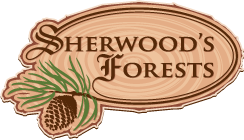Instant Forest
Just add water: a guide for the impatient
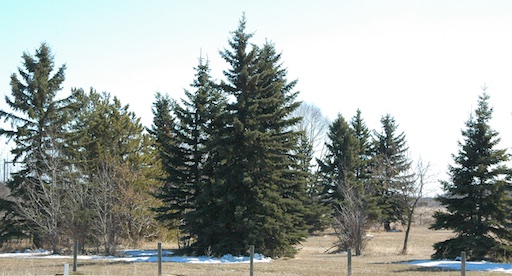
Non-Instant Forest: The spruce in this picture are about 20 years old. Pines would be half again taller, and poplar over twice as high.
If only it were that easy.
If you really want instant forest, buy a chunk of land that has trees on it. Seriously: You can move your house for less money than it takes to move 20 8-inch caliper trees. But it probably makes more sense to sell your house and look for a rural property with trees on it.
Money vs Time: The merits of starting small
Trees are sold by two measurements -- height and trunk diameter or caliper. Lots of new housing divisions require a 2" (50 mm) caliper tree to get your landscaping deposit back. A 2” tree costs $150-$300 and typically comes in a 25-40 gallon pot. It's 15 feet tall, and weighs 150-200 pounds. You do not want to plant a forest of them by hand. Your wallet will suffer for it and you will be on your chiropractor’s permanent Christmas card list. If you hire it done, you either hire someone with a bobcat to trample over your lawn, or you hire the local high school football team to help. Either option saves your back, but increases wallet pain. Calling 3 buddies, and doing it with pizza and beer is a good fallback.
Go two years younger. The tree is only 10 feet tall x 1" trunk diameter, and it's half the digging, half the weight, and a bit over half the price.
Suppose that you want a row of birch lining your driveway. It's a 300 foot long driveway. 600 feet because it has two sides. You decide to put a tree every 15 feet. That's 40 trees.
| Action | Cost per tree | Bill |
|---|---|---|
| A: Buy 2" trees from garden center. Hire them to plant. | $400 | $16000 |
| B: Buy 2" trees from garden center. Plant them yourself. | $200 | $8000 |
| C: Buy 1" trees from me. Hire me to plant them. | $150 | $6000 |
| D: Buy 1" trees from me. Plant yourself | $90 | $3600 |
| E: Buy 2 gallon trees from me. Hire me to plant them. | $30 | $1200 |
| F: Buy 2 gallon trees from me. Plant them yourself. | $15 | $600 |
When you buy a larger tree you are trading money for time. The difference is about 6 years for a fast growing tree. You can see that the interest rate is high -- about 75% compounded annually. Wouldn't you like your RRSP to show such returns?
Slow growing trees are more expensive. A tree that takes twice as long to get to 10 feet doesn't cost twice as much. The big expenses are mostly at the end when you dig it up and put it in a basket, but you are adding additional years of weeding, fertilizing, shooing the deer away. And your land is tied up. A tree that takes 10 years instead of 5 will cost about 60 to 80% more.
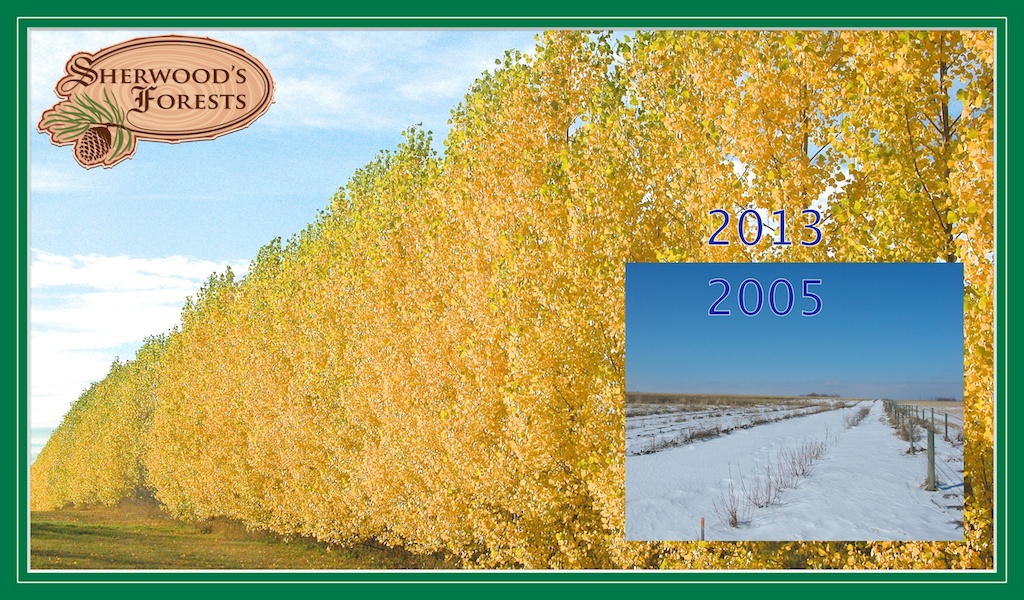
Some people think in numbers. Some in words. This picture visually drives home the real effect of compound interest.
I planted 400 12 inch poplar trees in 2005. They are now (2013) two proud shelterbelts 30 feet tall. In 8 years that little weed turned into a couple hundred pounds of tree. But in 30 more years, they will be ready to turn into firewood. (Live fast! Die young!) If you are interested in that project, look here Shelterbelts for some good pix showing the weedy runts’ metamorphosis into the half grown, but beautiful row they are today.
A Balanced approach
"But what can I doooo!" I hear you cry.
Here is my recommended compromise strategy: Plant a mix.
Plant one batch of trees that grow fast, so you have something in a very few years to show for it. Do a margin around the edge of your property at least. A row on either side of the driveway. A row to the south of the house to shade the house in summer, and provide a shady place in the evening. A row to the north and west of the house, about 25-75 feet away to block the winter wind. ("75 feet? Who has 75 feet?" Look, my target market is the family that owns at least 3 acres, and more likely 10 to 160 acres)
Plant a second batch that take longer to grow, but can hide between their faster living counterparts while they get their act together.
Plant a bunch of shrubs. They look good in just a couple of years. Some of them may get shaded out by the trees.
Plant ONE specimen tree that is big and wonderful. Hire it done if you need to. This makes a statement about your commitment to this patch of land.
Other things for instant forest
If you have a west side deck or patio, plant some fast growing trees west to northwest of the deck. This will put part of the deck in shade on late summer evenings.
You can plant shrub willows in half barrels. I suggest 'Flame' as it will provide winter interest too. Lilacs are slower, but many think they are more attractive. You may have issues with them blowing over in high winds once they get over 8 feet.
Put lots of drainage holes in the bottom of the barrel (about 1/3 of the area of the barrel bottom) Use real soil -- it's heavier. If you put the barrels on castor dollies you will be able to move them around as needed. Princess Auto has a large selection of big castors.
Cheap and Big and Fast
Once again the downtrodden cry out: "We spent everything on the house and the unexpected bills are killing us. We have no money at all!"
If you live rurally, you probably either have a pickup or have a friend who does. Or it's time to rent or buy a trailer you can tow behind your SUV. (As a side note: You are going to overload the trailer. Avoid the ones sold by Home Depot and Canadian Tire. The frames are too light. Get one rated for 1 ton, and get the appropriate hitch for your vehicle.
The Alberta government will sell you a permit to harvest wild trees on crown land. The permit costs $5 and allows you to take 20 conifers under 3 meters (10 feet) tall. In practice a tree this tall doesn't transplant well without equipment. But a 6 foot spruce transports quite easily.
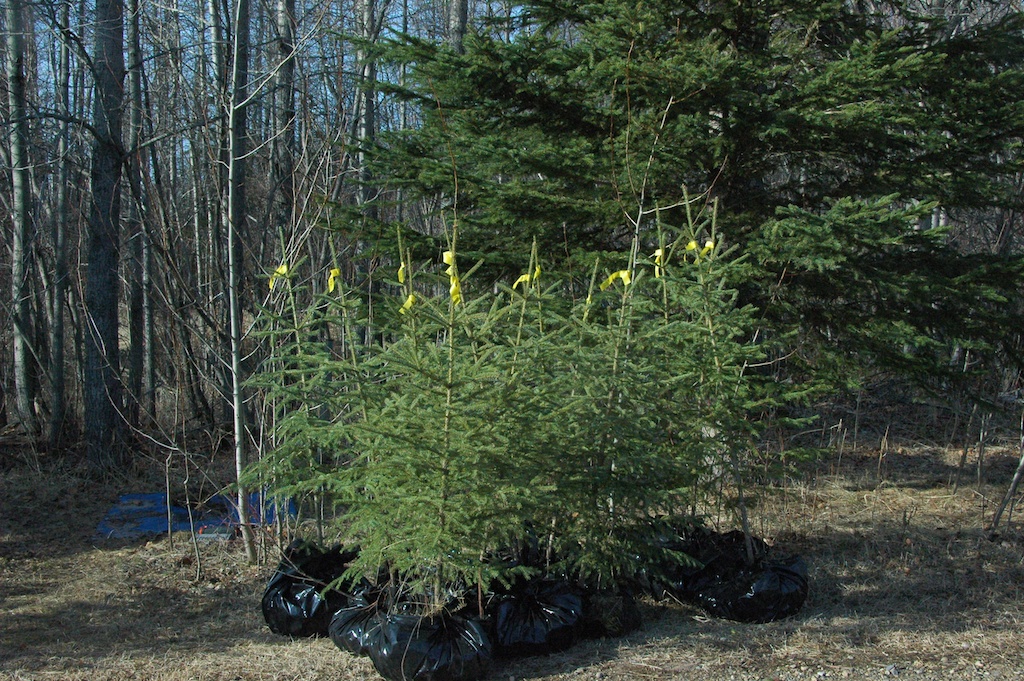
This was a long hot afternoon's work. Don't forget to bring a wheelbarrow.
You can also do this with a poplar or aspen up to about 1.5" trunk diameter. The two best times of year to do this are either in spring before the trees break bud, around the first of May, or in fall right after the leaves drop, around the last two weeks in September. Any adult can get a permit, but they MUST be present when the trees are dug and transported. A friend and I have done this as a cooperative venture a couple of times to add more spruce to my poplar bush and line his driveway. And no, you can't sell the extras.
If you try for pine, lower your expectations. Pine have deep roots. Anything larger than 4 feet is a bad bet.
The Trees
You came here to find out what grows fast.
Poplar That poplar shelterbelt has averaged over a meter a year. Plant 10 feet apart. If you water them three times a year (Late July, early September, late October) they will grow even faster. I can sell you poplar plugs (1 year old) for under $3; super plugs (soup can size root ball) for $5; 2 year old, 4 foot high trees for $15; and 3 year old, 6-7 foot trees in a 5 gallon pot for $25. More info about poplar.
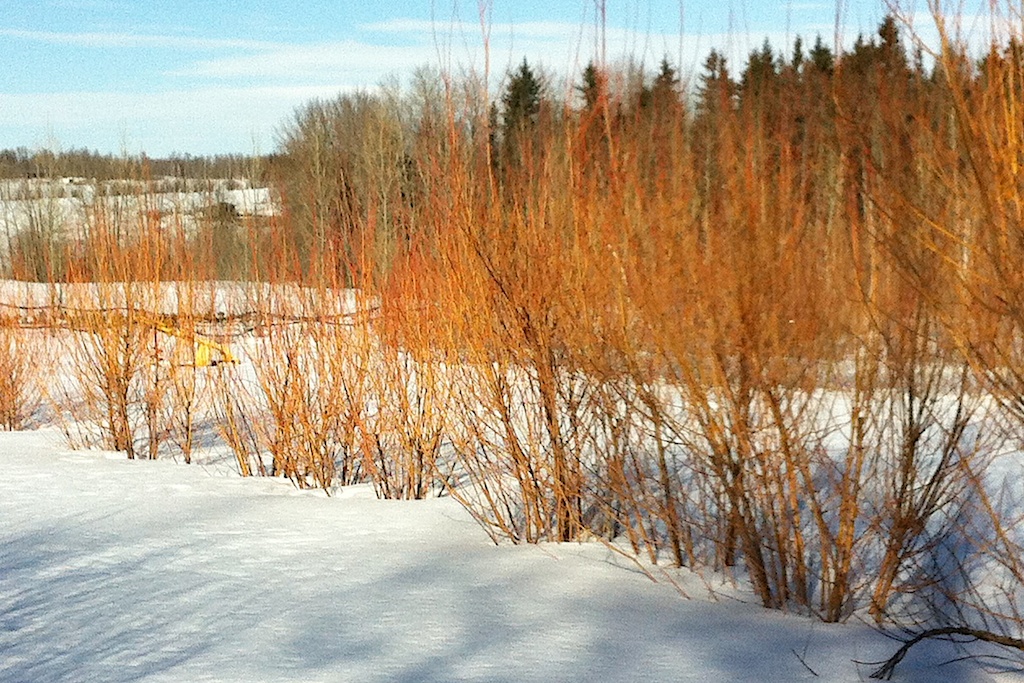
One advantage of Golden willow: That bright yellow twig color in winter. Prune hard for best effect. Plant 4 feet apart for hedge, 12 feet apart for tree row.
Willow Most of our willows are shrubs -- some quite large shrubs, but still shrubs. Good for marking the edge, good for reducing the dust pouring in from the gravel road. 3-4 years from planting to effective head height screening. This assumes you water them once a month during the first two years.
We do have some tree form willows. They start at the same size and just keep going. Willow info
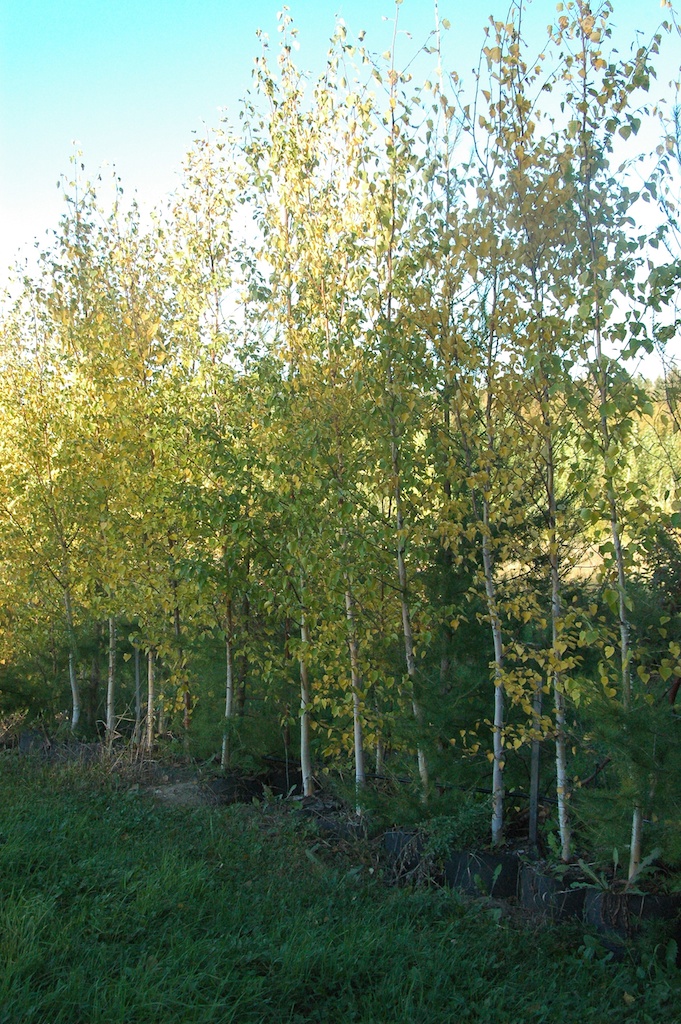
Paper Birch -- Native tree that does well on moist sites. Plant 10 feet from the house, and run the downspout out to it. Or plant on the slope of the road ditch. You will need to water for the first two years until the tree finds the bottom of the ditch.
Birch Birch will do 2-2.5 feet -- call it 3/4 of a meter per year. They like water. In the wild they grow only where there is an additional water supply close by: creek, runoff channel, slough, spring, hollow. If you are just starting your landscaping build a 'greenway'. This is a very broad, but very shallow ditch or swale. Think of how a road is crowned. Flip it over. 20 feet wide, 4 inches deep. Plant your birch in the bottom of it. (This works for poplar too.) More info on the Birch family
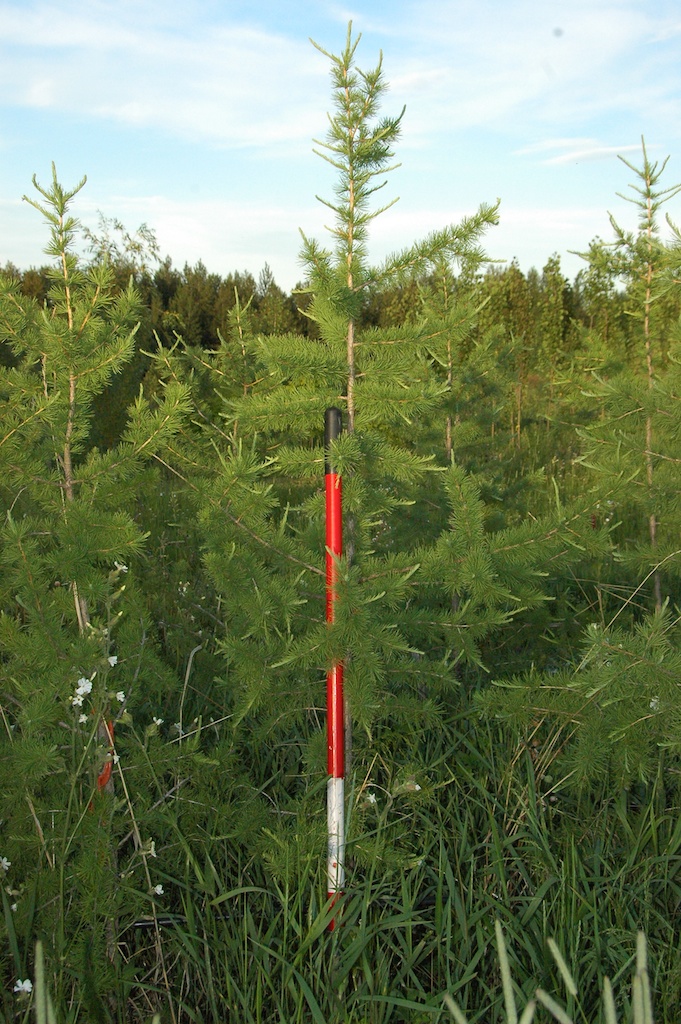
Siberian Larch
Siberian Larch grow 2-3 feet per year. Larches are odd ducks. They are deciduous conifers. In winter, that makes people think they are dead spruce trees. Use them as the back row, mix them with the poplar. Siberian Larch gets big. I have seen one that the lower branches spread out 15 feet in all directions. The owner had taken all the branches off the bottom 8 feet, and put a picnic table underneath. (On the back he left stubs of branches so the grandkids could climb into the crown.) Larch make great climbing trees. More info about Larches
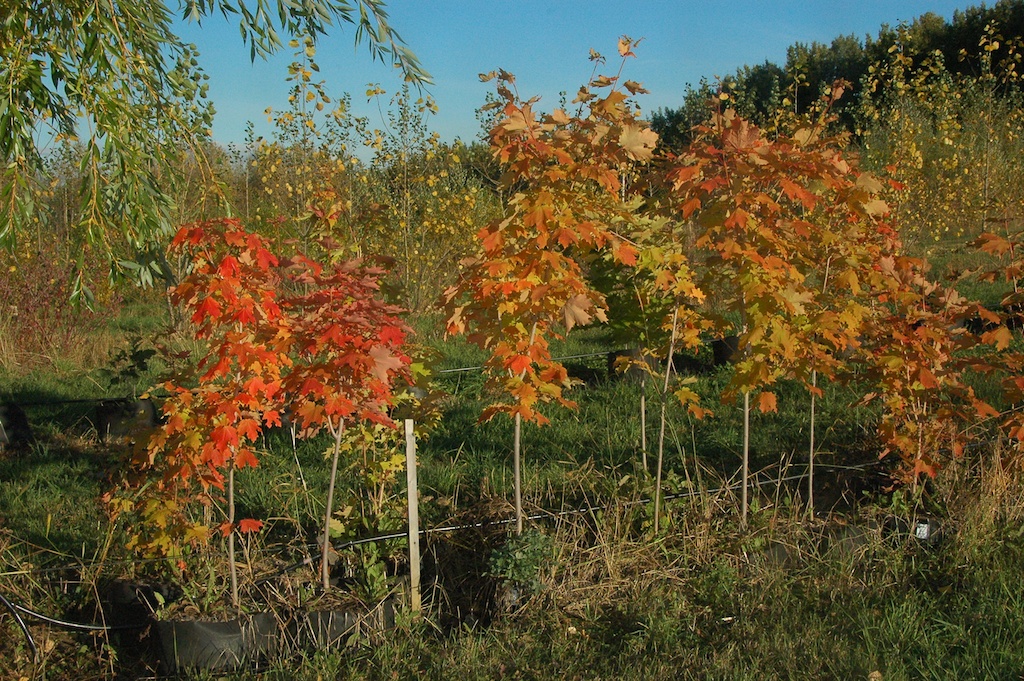
Sugar Maple, showing fall colours. Silver maple grows faster, but isn't nearly as pretty in fall.
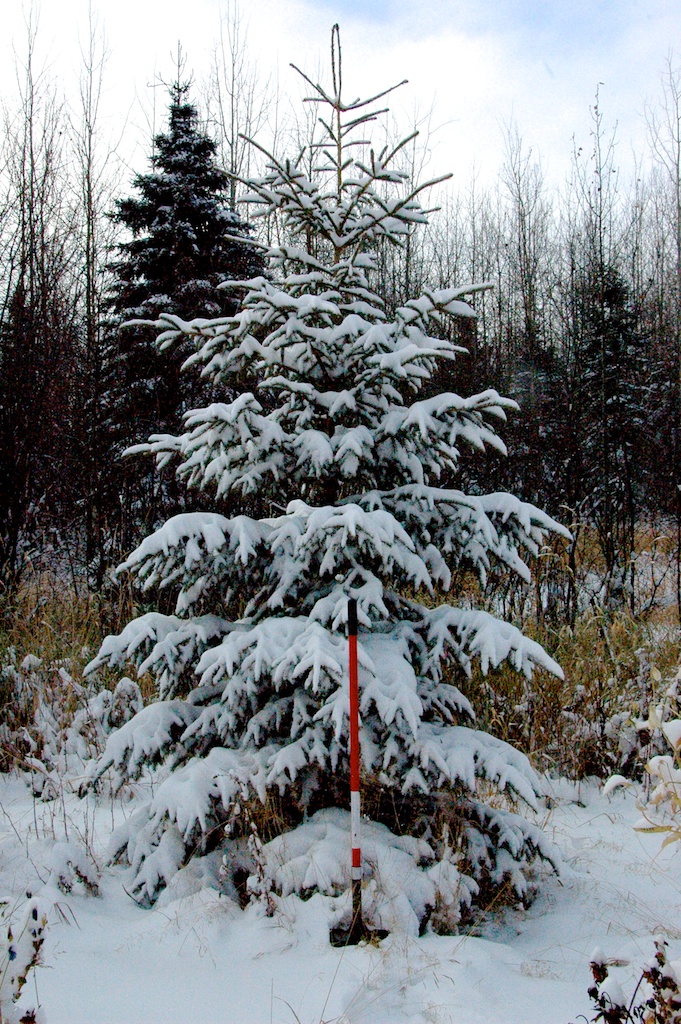
This is another seeding planted very early. Next fall, I'll string it with lights before the snow falls. Lovely.
Maples Maples are a large and varied group. I can recommend two for fast growth: Silver Maple will grow 2 feet a year, and gets quite wide. Manitoba maple is another fast growing shade tree. More info
"But I want something in winter too!" I hear you cry.

This lodgepole pine was a seeding in ten years ago, in 2003. It was one of the first trees I planted. The white stick in the picture is 8 feet long.
Pine The pines are half the speed of poplar. Foot and a half to two feet a year. The speedy one of the bunch for our climate is Lodgepole Pine. Scots pine comes close, and works better on clay. Neither like soggy soils. More info about Lodgepole here.
Spruce White spruce under good conditions will grow 12-18 inches a year. For a spruce, good conditions means an ounce of fertilizer per foot of height spread out over a circle that is 1 height in diameter and watering 3 times a year. Spruce is a good mixer with either poplar or pine, as it's shade tolerant. Both poplar and pine drop their lower branches with age, but spruce just keep getting wider at the bottom. More info about white spruce.
The next step
Read the individual species pages.
Read the other solutions pages for more ideas. The trees mentioned on this page are some of the faster trees I have, but there are so many other ideas and considerations. Shade. Fruit. Design. Working with garden space. Outdoor living areas.
Inventory is online -- sort of. Not updated often enough. If you don't see something there, ask. I may have it, but it's not on the list. If you do see something, again, ask. I may have sold all of it. At this point (spring 2014) it does not contain any of the stuff mentioned in the Pre-Orders area of the web site.
Remember: Decide on a budget. Decide what you want to do, or what your priorities are. You don't have to do it all in one year. It is important to start. Longest journey and all that.
Feel free to call me, or if you don't have a good long distance plan, ask me to call you. Evenings are best for this.
Got something to say? Email me: sfinfo@sherwoods-forests.com
Interesting? Share this page.
Want to talk right now? Call me: (8 am to 8 pm only, please) 1-780-848-2548
Do not arrive unannounced. Phone for an appointment. Why? See Contact & Hours That same page gives our hours of operation.
Back to Top
Copyright © 2008 - 2021 S. G. Botsford
Sherwood's Forests is located about 75 km southwest of Edmonton, Alberta. Please refer to the map on our Contact page for directions.
